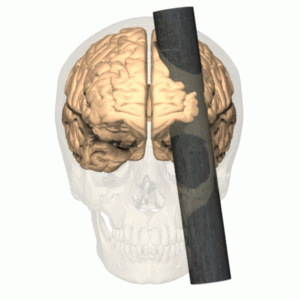Psychology Addict # 6 | Phineas Gage - The most famous Brain in Neuroscience

Did Phineas´personality really change after his accident?
In the fascinating story of Phineas Gage, as curious as the endurance of his brain to the unfortunate accident, are the tales that ensued about his personality change following his recovery. Gage, who pre-accident was described as a reliable, friendly and respectful fellow; after having a tamping-iron fully propelled into his left check all the way through his skull, was described as someone profane and impatient. This depiction of Gage entered popular culture and 160 years later is still a subject for plays, movies and even lawyers!
The accident

It all happened in 1848 when very little was known about the functions of the brain. At the age of 25, Phineas Gage was working as a foreman for a Railroad construction company cutting through rocks in Central Vermont in the USA. As the foreman, Gage was the one who decided which rock would be blasted, therefore determining how much powder the explosion would require. Before lighting the fuse, sand was added; to tamp it down a special crowbar-like rod was the tool of choice!
The story goes that Gage made a mistake with the tamping due to a minor distraction. This resulted in an explosion that sent the iron bar 25 yards behind him after travelling through his skull as it penetrated his cheek just behind his left eye. Gage fell backwards, stood up in full consciousness a few minutes later with the help of his peers, who put him on the back of an ox-cart and took him to the inn where he was living. There, sitting on a chair in the balcony while awaiting the doctor he told his story to passers-by. When Dr. Williams arrived, Gage exclaimed ‘Doctor, here is business enough for you.’ So, one thing that could be said about his personality is that he had a good-sense of humour.
What happened next?
Phineas died in 1860, after a successive series of seizures, in his mother’s house, to where he returned after making a living for many years as a stagecoach driver in Chile.
When he died no autopsy was done to his brain and there was no remains of it when, seven year later, his body was exhumed. As professor McMillan points out ‘Phinea’s skull is all we have as a guide to the damage.’ Thus, with no certainty of which areas of his brain were affected, the conclusions about his personality changes become little more than mere speculation, and hearsay. Very little was known about him before the accident anyway.
To make matters worse, the one possible reliable source about Gage could have been one of his physicians, Dr. Harlow; but, disappointingly, records show that even his notes about Gage contained misinformation. For example, his reports about Phinea’s death show that it happened in 1961, while the records in funeral parlours state it was in 1960. Also, Dr. Harlow’s notes declared that Gage went to Chile in 1952, while relics curated by the professionals of the Harvard’s Warren Anatomical Museum suggest the trip took place in 1954.
Conclusion
Too little is known about Phineas Gage before and after his tragic accident. Plus, as argued by Dr. McMillan, at this point, facts and fiction are so intertwined that it would be hard to establish which is which. However, it is important to be aware of the fact that the many ways Phineas Gage’s account was viewed had a lot to do with particular interests to support certain theories. Therefore, this should better be a case mainly regarded as the first documented occurrence in history where changes in personality were caused by damages in the brain focusing more on the historical landmark it lent to neuroscience, rather than its neuropsychological aspects.
References
McMillan, M. (2000), An odd kind of fame: Stories of Phineas Gage. Cambridge, Ma, MIT Press.
McMillan, M (2008), Phineas Gage - Unravelling the myth, The Psychologist, vol. 21, no. 9, pp. 828-32.
This is really interesting. Never heard of such thing. I wonder where you find material like this.. keep it coming please! best. :-)
Oh! Thanks for stopping by @agneslazco. I am glad you liked it! I am a psychology student. So, this is the kind of material I read day-in, day-out!
I really appreciate your comment 🙃
Thanks!
Amazing how in this day and age, we still don't know much about how the brain works.
Thanks for posting!
Thank you for taking the time to read and comment @silent.screamer. I do think we have made considerable progress in this field, though. Specially if our time line starts at Gage's days ! 😉